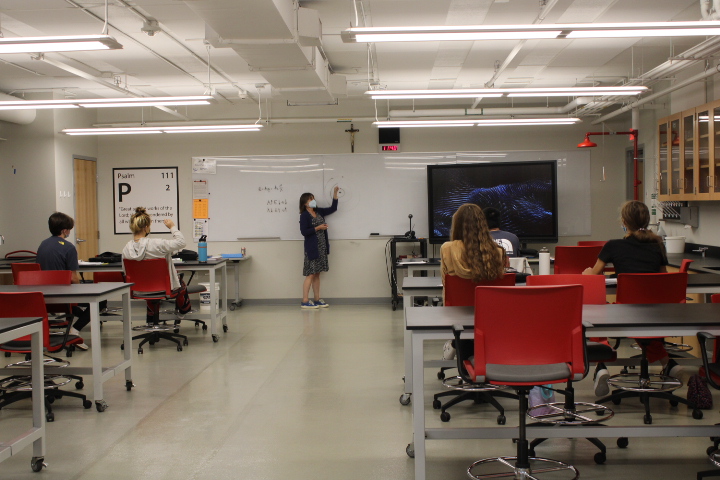Inside BSM’s Smallest Classes
AP chemistry with Ms. Bargas is one of the smallest classes at BSM this year with only 6 students.
September 21, 2021
While Benilde-St. Margaret’s boasts a class size average of just above 20 students, BSM’s language department is home to some irregularly tiny class sizes, especially when it comes to more advanced language courses.
BSM requires students to take two full years of a world language in order to fulfill the minimum requirements for graduation. Although BSM’s course program handbook recommends that students exceed these requirements, the high school’s more advanced language classes tend to be much smaller than their lower level counterparts. “Most of the smallest classes are in world language, or engineering,” Assistant Principal Matt Weingartz said.
Spanish teacher Matthew McMerty-Brummer teaches multiple different courses. His most advanced class, Español Para Hispanohablantes III, is no exception to this trend. With a total of just eight students, it is one of the smallest classes at BSM. In a smaller class, each student has more weight to carry in terms of class participation. “I do think that there are more opportunities for student participation in smaller classes,” McMerty-Brummer said.
Going even deeper into the language department, and BSM’s basement, Latin teacher Rob Epler has a class of just five students this year. Mr. Epler’s Latin V class is home to students who have been with him for pretty much their entire high school careers. “Going back to when my main job was ninth through 12th… but now there have been — even before I took over the junior high program — years where I got eighth graders. So then the Latin V kids that’d be five years I have with them,” Epler said.
However, with the new task of teaching Latin to all grade levels at BSM, there is a possibility of a Latin VI class being a realistic addition to the class roster, and with it, the potential for even smaller classes. Epler’s Latin V class for this year has a junior in it, which is a first for the course. “So I have that one down because… theoretically, we could do a Latin VI. There isn’t a curriculum for that now, so we’ll see,” Epler said.
A smaller class size also lessens the burden of learning how a new group of students functions, and also makes it much easier for teachers to get to know their students and be more comfortable teaching them. “I will say working with the smaller group that I have worked with for a long time and I know better just feels easier,” Epler said.
Students in such small classes at such high levels oftentimes have multiple classes with the same group of peers from past years, and are more comfortable with interacting with their classmates at the start of the year than a standard class. “In the Hispanohablantes classes, students have shared that they often feel more comfortable participating because they have been together for several years and know each other better, as compared to beginning in a class with lots of students they do not know well,” McMerty-Brummer said.






































![Teacher Lore: Mr. Hillman [Podcast]](https://bsmknighterrant.org/wp-content/uploads/2025/03/teacherlorelogo-1200x685.png)












